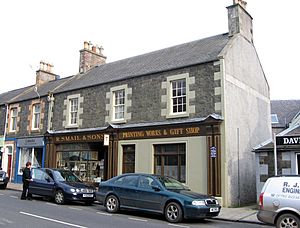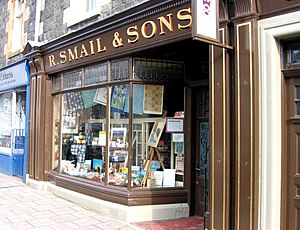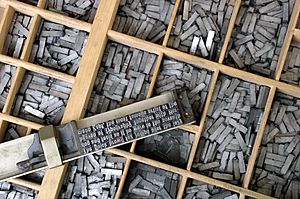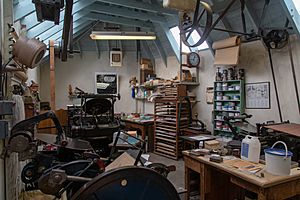Robert Smail's Printing Works facts for kids
Robert Smail's Printing Works is a super cool old printing shop in Innerleithen, a small town in the Scottish Borders. It's like stepping back in time to the Victorian era! This place is a working museum, kept alive by The National Trust for Scotland. Visitors can see how people printed things around the year 1900. They even still print real orders for people and businesses today!
Contents
History of the Printing Works
This printing business started way back in 1866. It printed all sorts of things for the local community. It also had a shop that sold paper and other writing supplies. For many years, between 1893 and 1916, they even printed a weekly newspaper!
The Smail family owned the business for a long time. They didn't really update their machines with new technology. Because of this, the printing works stayed much like it was in the old days.
In 1986, the National Trust for Scotland took over the property. It opened to the public as a museum in 1990. Today, visitors can take a one-hour tour. You get to see all the different steps of printing. Sometimes, you can even try setting type by hand or printing your own work! The building is a special historic site, protected by law.
Exploring the Printing Works
The printing works is in a two-story building on the main street. On the ground floor, there's a shop and an office. The shop is now where visitors enter and can buy gifts. The office has its own door to the street. It also connects to the shop.
Inside the office, you'll see a big desk by the window. It looks just like an office from the early 1900s! Drawers are full of old writing supplies. You might find writing slates, pencils, and bottles of ink. Shelves on the walls hold old records. These include job tickets, bills, and wage books. Some records go all the way back to when the business started! Pictures on the walls show that the office hasn't changed much since 1900. There's even an old certificate. It shows they could sell tickets for steamships going to America!
Paper Store and Caseroom
A door at the back leads to the paper store. This big room holds an amazing collection. It has almost every single thing they printed for a hundred years! At one end of the room, you can see a rebuilt water wheel. This wheel used to power the printing machines.
Stairs go up to the caseroom. This is a large room where people set type. Along the walls, there are racks of drawers. These drawers are called letter cases. Each case holds different metal letters. The racks are about waist height. The cases of letters that workers use sit on top. The case for small letters (lowercase) is tilted slightly. The case for capital letters (uppercase) stands behind it, leaning against the wall.
The letters are made of metal. They are called movable type. A printer will show visitors how to pick out these letters. You place them by hand into a metal tool called a composing stick. After you set your words, the printer puts them together. If there's time, they might even print what you set! This creates a "galley proof." The room also has many other sets of type. These were made for jobs that might be printed again later. One of these is the very last job set by Cowan Smail, the last family owner. It says "Closing Down Sale from Today."
Machineroom
The machineroom is also a large room. It holds several different printing presses. One is a pedal-operated press that you feed paper into by hand. There's also a very large machine called a 'Wharfedale Reliance'. This machine was bought in the 1870s. It used to be powered by a belt connected to the water wheel. The newest machine is an automated 'Heidelberg Platen'. It was bought in 1952. A printer at the museum will show visitors how these amazing machines work.
Events and Workshops
Robert Smail's Printing Works holds special printing workshops in the winter. They also take part in local events. For example, they join the Innerleithen Honey Festival. In September 2007, they started "living history tours." These tours celebrated 500 years of printing in Scotland.
Other Places to Visit Nearby
The National Trust for Scotland looks after other interesting places in the Scottish Borders:
- Priorwood Garden
- Harmony Garden
- St Abb's Head National Nature Reserve






